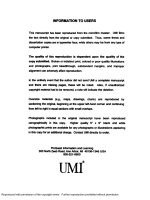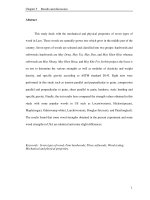Bias - Types of bias
Bạn đang xem bản rút gọn của tài liệu. Xem và tải ngay bản đầy đủ của tài liệu tại đây (2.08 MB, 14 trang )
Section 2
Bias
Chapter
4
Typesofbias
What the doctor saw with one, two, or three patients may be both acutely noted and
accurately recorded; but what he saw is not necessarily related to what he did.
Austin Bradford Hill (Hill, 1962; p. 4)
e issue of bias is so important that it deserves even more clarication than the discussion
IgaveinChapter 2. In this chapter, I will examine the two basic types of bias: confounding
and measurement biases.
Confounding bias
To restate, the basic notion of confounding bias was shown in Figure 2.1, the “eternal triangle”
of the epidemiologist.
e idea is that we cannot believe our eyes; that in the course of observation, other fac-
tors of which we may not be aware (confounding factors) could be inuencing our results.
e associations we think are happening (between treatment and outcome, or exposure and
result)maybeduetosomethingelsealtogether.Wehaveconstantlytobeskepticalabout
what we think we see; we have to be aware of, and even expect, that what seems to be hap-
peningisnotreallyhappeningatall.etruthliesbelowthesurfaceofwhatisobserved:the
“facts” cannot be taken at face value.
Put in epidemiological language: “Confounding in its ultimate essence is a problem with
a particular estimate – a question of whether the magnitude of the estimate at hand could be
explained in terms of some extraneous factor” (Miettinen and Cook, 1981). And again: “By
‘extraneous factor’ is meant something other than the exposure or the illness – a characteristic
of the study subjects or of the process ofsecuring information on them” (Miettinen and Cook,
1981).
Confounding bias is handled either by preventing it, through randomization in study
design,orbyremoving it, through regression models in data analysis. Neither option is guar-
anteed to remove all confounding bias from a study, but randomization is much closer to
being denitive than regression (or any other statistical analysis, see Chapter 5): one can bet-
ter prevent confounding bias than remove it aer the fact.
Another way of understanding the cardinal importance of confounding bias is to recog-
nize that all medical research is about getting at the truth about some topic, and to do so one
has to make an unbiased assessment of the matter at hand. is is the basic idea that underlies
what A. Bradford Hill called “the philosophy of the clinical trial.” Here is how this founder
of modern epidemiology explained the matter:
...ereactions of humanbeingsto most diseasesare,underanycircumstances,
extremely variable. ey do not all behave uniformly and decisively. ey vary, and
that is where the trouble begins. ‘What the doctor saw’ with one, two, or three patients
Section 2: Bias
may be both acutely noted and accurately recorded; but what he saw is not necessarily
related to what he did. e assumption that it is so related, with a handful of patients,
perhaps mostly recovering, perhaps mostly dying, must, not infrequently, give credit
where no credit is due, or condemn when condemnation is unjust. e eld of
medical observation, it is necessary to remember, is oen narrow in the sense that no
one doctor will treat many cases in a short space of time; it is wide in the sense that a
great many doctors may each treat a few cases. us, with a somewhat ready
assumption of cause and eect, and, equally, a neglect of the laws of chance, the
literature becomes lled with conicting cries and claims, assertions and
counterassertions. It is thus, for want of an adequately controlled test, that various
forms of treatment have, in the past, become unjustiably, even sometimes harmfully,
establishedineveryday medicalpractice...It isthisbelief, orperhapsstateofunbelief,
that has led in the last few years to a wider development in therapeutics of the more
deliberately experimental approach.
(Hill, 1962; pp. 3–4; my italic)
Hill is referring to bloodletting and all that Galenic harm that doctors had practiced since
Christ walked the earth. It is worth emphasizing that those who cared about statistics in
medicine were interested as much, if not more, in disproving what doctors actually do,rather
than proving what doctors should do. We cause a lot of harm, we always have, as clinicians,
andwelikelystillare.emainreasonforthismorallycompellingfactisthisphenomenon
of confounding bias. We know not what we do, yet we think we know.
is is the key implication of confounding bias, that we think we know things are such-
and-such,butinfacttheyarenot.ismightbecalledpositive confounding bias: the idea that
there is a fact (drug X improves disease Y) when that fact is wrong. But there is also another
kind of confounding bias; it may be that we think certain facts do not exist (say, a drug does
not cause problem Z), when that fact does exist (the drug does cause problem Z). We may not
be aware of the fact because of confounding factors which hide the true relationship between
drug X and problem Z from our observation: this is called negative confounding bias.
We live in a confounded world: we never really know whether what we observe actually is
happening as it seems, or whether what we fail to observe might actually be happening.
Let us see examples of how these cases play out in clinical practice
Clinical example 1 Confounding by indication: antidepressant discontinuation in bipolar
depression
Confounding by indication (also called selection bias) is the type of confounding bias of which
clinicians may be aware, though it is important to point out that confounding bias is not just
limited to clinicians selecting patients non-randomly for treatment. There can also be other
factors that influence outcomes of which clinicians are entirely unaware, or which clinicians
do not influence at all (e.g, patients’ dietary or exercise habits, gender, race, socioeconomic
status). Confounding by indication, though, refers to the fact that, as mentioned in Chapter 2,
clinicians practice medicine non-randomly: we do not haphazardly (one hopes) give treatments
to patients; we seek to treat some patients with some drugs, and other patients with other
drugs, based on judgments about various predictive factors (age, gender, type of illness, kinds
of current symptoms, past side effects) that we think will maximize the chances that the
patient will respond to the treatments we provide. The better we are in this process, the better
our patients do, and the better clinicians we are. However, being a good clinician means that
we will be bad researchers. If we conclude from our clinical successes that the treatments we
14
Chapter 4: Types of bias
use are quite effective, we may be mistaking the potency of our pills for our own clinical skills.
Good outcomes simply mean that we know how to match patients to treatments; it does not
mean that the treatments, in themselves or in general, are effective. To really know what the
treatments do, we need to disentangle what we do, as clinicians, from what the pills do, as
chemicals.
An example of likely confounding by indication from the psychiatric literature follows: An
observational study of antidepressant discontinuation in bipolar disorder (Altshuler et al.,
2003) found that after initial response to a mood stabilizer plus an antidepressant, those who
stayed on the combination stayed well longer than those in whom the antidepressant was
stopped. In other words, at face value, the study seems to show that long-term continuation
of antidepressants in bipolar disorder appears to lead to better outcomes. This study was
published in the American Journal of Psychiatry (AJP) without any further statistical analysis,
and this apparent result was discussed frequently at conferences for years subsequent to its
publication.
But the study does not pass the first test of the Three C’s. The first question, and one never
asked by the peer reviewers of AJP (see Chapter 15 for a discussion of peer review), is whether
there might be any confounding bias in this observational study.
Readers should begin to assess this issue by putting themselves in the place of the
treating clinicians. Why would one stop the antidepressant after acute recovery? There is a
literature that suggests that antidepressants can cause or worsen rapid-cycling in patients
with bipolar disorder. So if a patient has rapid-cycling illness, some clinicians would be
inclined to stop the antidepressant after acute recovery. If a patient had a history of
antidepressant-induced mania that was common or severe, some clinicians might not
continue the antidepressant. Perhaps if the patient had bipolar disorder type I, some clinicians
would be less likely to continue antidepressants than if the patient had bipolar disorder
type II. These are issues of selection bias, or so called confounding by indication: the doctor
decides what to do non-randomly. Another way to frame the issue is this: we don’t know how
many patients did worse because they were taken off antidepressants versus how many were
taken off because they were doing worse. There may also be other confounders that just
happen to be the case: there may be more males in one group, a younger age of onset in one
group, or a greater severity of illness in one group. To focus only on the potential confounding
factor of rapid-cycling, if the group in whom antidepressant was stopped had more rapid
cyclers (due to confounding by indication) than the other group (in whom the antidepressant
was continued), then the observed finding that the antidepressant discontinuation group
relapsed earlier than the other group would be due to the natural history of rapid-cycling
illness: rapid cyclers relapse more rapidly than non-rapid cyclers. This would then be a classic
case of confounding bias, and the results would have nothing to do with the antidepressants.
It may not be, in fact, that any of these potential confounders actually influenced the
results of the study. However, the researchers and readers of the literature should think about
and examine such possibilities. The authors of such studies usually do so in an initial table of
demographic and clinical characterisitics (often referred to as “Table One” because it is
needed in practically every clinical study, see Chapter 5). The first table should generally be a
comparison of clinical and demographic variables in the groups being studied to see if there
are any differences, which then might be confounders. For instance, if 50% of the
antidepressant continuation group had rapid-cycling and so did 50% of the discontinuation
group, then such confounding effects would be unlikely, because both groups are equally
exposed. The whole point of randomized studies is that randomization more or less
guarantees that all variables will be 50–50 distributed across groups (the key point is equal
representation across groups, no matter what the absolute value of each variable is within
15
Section 2: Bias
each group, i.e., 5% vs. 50% vs. 95%). In an observational study, one needs to look at each
variable one by one. If such possible confounders are identified, the authors then have two
potential solutions: stratification or regression models (see below).
It is worth emphasizing that the baseline assessment of potential confounders in two
groups has nothing to do with p-values. A common mistake is for researchers to compare two
groups, note a p-value above 0.05, and then conclude that there is “no difference” and thus no
confounding effect. However, such use of p-values is generally thought to be inappropriate, as
will be discussed further below, because such comparisons are usually not the primary
purpose of the study (the study might be focused on antidepressant outcome, not age or
gender differences between groups). In addition, such studies are underpowered to detect
many clinical and demographic differences (that is they have an unacceptably high possibility
of a false negative or type II error), and thus p-value comparisons are irrelevant.
Perhaps the most important reason that p-values are irrelevant here is that any notable dif-
ference, even if not statistically significant, in a confounding factor (e.g., severity of illness), may
have a major impact on an apparently statistically significant result with the experimental vari-
able (e.g., antidepressant efficacy). Such a confounding effect may be big enough to completely
swamp, or at least lessen the difference on the experimental variable such that a previously
statistically significant (but small to moderate in effect size) result is no longer statistically signif-
icant. How large can such confounding effects be? The general rule of 10% or larger, irrespective
of statistical significance, seems to hold (see Chapter 9). The major concern is not whether
there is a statistically significant difference in a potential confounder, but rather whether
there is a difference big enough to cause concern that our primary results may be distorted.
Clinical example 2 Positive confounding: antidepressants and post-stroke mortality
An example of standard confounding, another that went unnoticed in the AJP, is perhaps a bit
tricky because it occurred in the setting of a randomized clinical trial (RCT). How can you have
confounding bias in RCTs, the reader might ask? After all, RCTs are supposed to remove
confounding bias. Indeed, this is so if RCTs are successful in randomization, i.e., if the two
groups are equal on all variables being assessed in relation to the outcome being reported.
However, there are at least two major ways that even RCTs can have confounding bias: first,
they may be small in size and thus not succeed in producing equalization of groups by
randomization (see Chapter 5); second, they may be unequal in groups on potential
confounding factors in relation to the outcome being reported (i.e., on a secondary outcome,
or a post-hoc analysis, even though the primary outcome might be relatively unbiased, see
Chapter 8).
Here we have a study of 104 patients randomly given 12 weeks double-blind treatment of
nortriptyline, fluoxetine, or placebo soon after stroke (Jorge et al., 2003). According to the
study abstract: “Mortality data were obtained for all 104 patients 9 years after initiation of the
study.” In those who completed the 12-week study, 48% had died in follow-up, but more of
the antidepressant group remained alive (68%) than placebo (36%, p = 0.005). The abstract
concludes: “Treatment with fluoxetine or nortriptyline for 12 weeks during the first 6 months
post stroke significantly increased the survival of both depressed and nondepressed patients.
This finding suggests that the pathophysiological processes determining the increased
mortality risk associated with poststroke depression last longer than the depression itself and
can be modified by antidepressants.”
Now this is quite a claim: if you have a stroke and are depressed, only three months of
treatment with antidepressants will keep you alive longer for up to a decade. The observation
seems far-fetched biologically, but it did come from an RCT; it should be valid.
16
Chapter 4: Types of bias
Once one moves from the abstract to the paper, one begins to see some questions rise up.
As with all RCTs (Chapter 8), the first question is whether the results being reported were the
primary outcome of the clinical trial; in other words, was the study designed to answer this
question (and hence adequately powered and using p-values appropriately)? Was this study
designed to show that if you took antidepressants for a few months after stroke, you would be
more likely to be alive a decade later? Clearly not. The study was designed to show that
antidepressants improved depression 3 months after stroke. This paper, published in AJP in
2003, does not even report the original findings of the study (not that it matters); the point is
that one gets the impression that this study (of 9-year mortality outcomes) stands on its own,
as if it had been planned all along, whereas the more clear way of reporting the study would
have been to say that after a 3 month RCT, the researchers decided to check on their patients
a decade later to examine mortality as a post-hoc outcome (an outcome they decided to
examine long after the study was over). Next one sees that the researchers had reported only
the completer results in the abstracts (i.e., those who had completed the whole 12-week initial
RCT), which, as is usually the case, are more favorable to the drugs than the intent-to-treat
(ITT) analysis (see Chapter 5 for discussion of why ITT is more valid). The ITT analysis still
showed benefit but less robustly (59% with antidepressants vs. 36% with placebo,
p = 0.03).
We can focus on this result as the main finding, and the question is whether it is valid. We
need to ask the confounding question: were the two groups equal in all factors when followed
up to 9-year outcome? The authors compared patients who died in follow-up (n = 50) versus
those who lived (n = 54) and indeed they found differences (using a magnitude of difference
of 10% between groups, see Chapter 5) in hypertension, obesity, diabetes, atrial fibrillation,
and lung disease. The researchers only conducted statistical analyses correcting for diabetes,
but not all the other medical differences, which could have produced the outcome (death)
completely unrelated to antidepressant use. Thus many unanalyzed potential confounding
factors exist here. The authors only examined diabetes due to a mistaken use of p-values to
assess confounding and this mistake was pointed out in a letter to the editor (Sonis, 2004). In
the authors’ reply we see their lack of awareness of the major risk of confounding bias in such
post-hoc analyses, even in RCTs: “This was not an epidemiological study; our patients were
randomly assigned into antidepressant and placebo groups. The logic of inference differs
greatly between a correlation (epidemiological) study and an experimental study such as
ours.” Unfortunately not. Assuming that randomization effectively removes most
confounding bias (see Chapter 5), the logic of inference only differs between the primary
outcome of a properly conducted and analyzed RCT and observational research (like
epidemiological studies); but the logic of inference is the same for secondary outcomes and
post-hoc analyses of RCTs as it is for observational studies. What is that logic? The logic of the
need for constantly being aware of, and seeking to correct for, confounding bias.
One should be careful here not to be left with the impression that the key difference is
between primary and secondary outcomes; the key issue is that with any outcome, but
especially secondary ones, one should pay attention to whether confounding bias has been
adequately addressed.
Clinical example 3 Negative confounding: substance abuse and
antidepressant-associated mania
The possibility of negative confounding bias is often underappreciated. If one only looks at
each variable in a study, one by one (univariate), compared to an outcome, each one of them
might be unassociated; but, if one puts them all into a regression model, so that confounding
17









